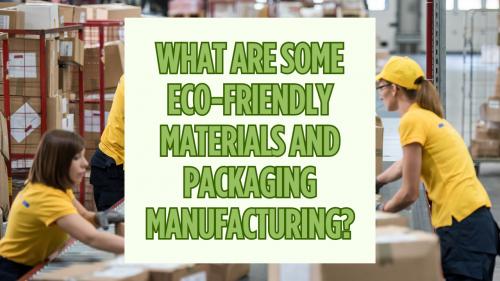What Are Some Eco-Friendly Materials and Packaging Manufacturing?

Nowadays, eco-friendly packaging materials are gaining popularity as these manufacturing options aim to reduce the environmental impact. As consumers become more environmentally aware, businesses are seeking innovative ways to reduce their carbon footprint and contribute to a greener planet. In this article, we will explore some of the eco-friendly materials and packaging manufacturing techniques that are gaining popularity, as suggested by experts of a Logo Design company in the UK.
1. Biodegradable
Plastics:
Traditional plastics have long been a major contributor to environmental degradation due to their non-biodegradable nature. However, the rise of biodegradable plastics offers a promising alternative. These plastics are designed to break down into natural substances, such as water, carbon dioxide, and biomass, through the action of microorganisms.
2. Recycled
Paper and Cardboard:
The production of paper and cardboard from recycled materials significantly reduces the demand for virgin wood pulp. Recycling paper not only conserves forests but also requires less energy compared to the production of paper from raw materials.
3. Biodegradable
packaging
materials:
Beyond plastics, various packaging materials are now being produced with biodegradability in mind. Packaging made from materials like mushroom-based mycelium, seaweed, and cornstarch offers a sustainable alternative. These materials decompose naturally, leaving behind minimal environmental impact.
4. Reusable
Packaging:
One of the most effective ways to minimize environmental impact is by encouraging the use of reusable packaging. Materials such as glass, metal, and certain types of plastic can be easily cleaned and reused, reducing the need for single-use packaging.
5. Plant-Based
Fabrics:
The fashion industry is notorious for its environmental impact, particularly in terms of textile production. However, the emergence of plant-based fabrics, such as organic cotton, hemp, and bamboo, has provided a more sustainable alternative to conventional materials. These fabrics are grown without the use of harmful pesticides and often require less water, making them more environmentally friendly throughout their life cycle.
6. Eco-Friendly
Inks and Dyes:
In the printing industry, the choice of inks and dyes plays a crucial role in determining the environmental impact of packaging. Water-based and vegetable-based inks are gaining popularity due to their lower levels of volatile organic compounds (VOCs) and reduced environmental footprint. Additionally, advancements in dyeing techniques are allowing for the use of natural, plant-derived dyes, further minimizing the ecological impact of textile manufacturing.
7. Reduced
packaging design:
A minimalist approach to packaging design is gaining traction as companies seek ways to reduce excess waste. Streamlined packaging not only uses fewer materials but also contributes to a more efficient supply chain, reducing transportation-related emissions. This approach aligns with the concept of "right-sizing" packaging, ensuring that the size and weight of the packaging match the product's requirements without compromising on protection.
Summing
it up, eco-friendly materials like bamboo, recycled paper, and biodegradable
plastics are revolutionizing packaging manufacturing, reducing environmental
impact, and promoting sustainability in the production process. By
incorporating these eco-friendly materials and practices, manufacturers can
contribute to a more sustainable and environmentally friendly approach to
packaging. It's important to consider the entire life cycle of materials and
packaging to minimize their impact on the planet.
To achieve sales in the UK, your product’s packaging design should be top-notch. Hence visit GB Logo Design.
Also
Read: How To Get Better Website Responsiveness: 10 Strategies That Work
Post Your Ad Here
Comments